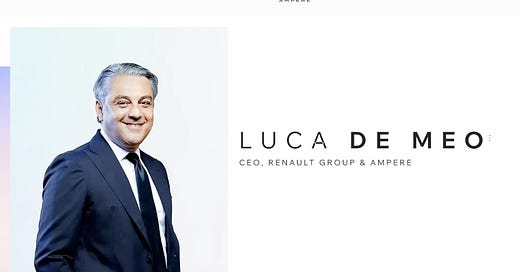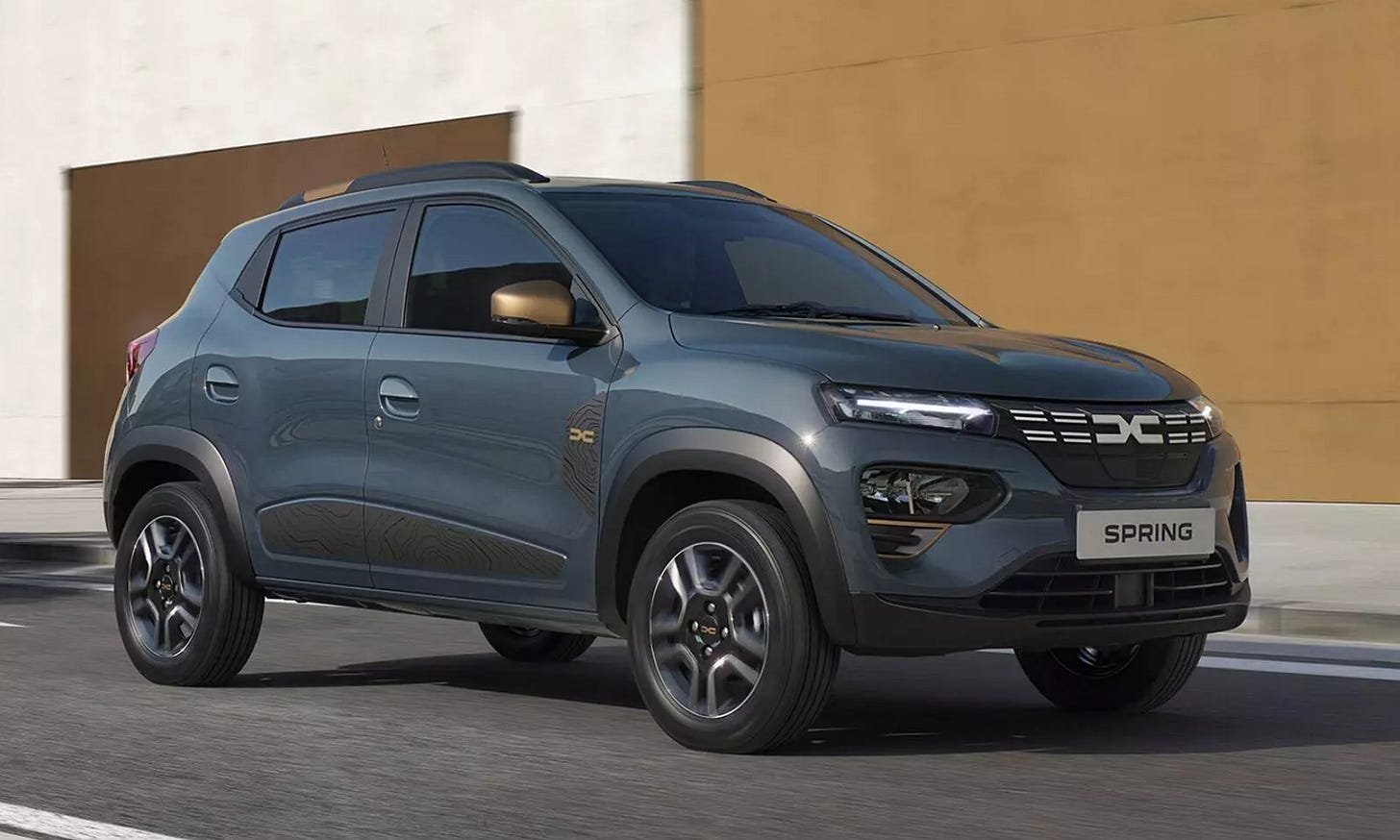Renault Ampere CEO Luca de Meo Outlines Bold Vision for Electric Vehicles
When one thinks about electric vehicles, one thinks immediately about Tesla and Elon Musk. But there is now a new, and important, voice, in the person of Luca de Meo, the CEO of Ampere Renault.
When one thinks about electric vehicles, one thinks immediately about Tesla and Elon Musk. This has been so for the past 15 years. Musk’s vision for EVs is dominant and extremely influential.
But there is now a new, and important, voice, in the person of Luca de Meo, who is the new CEO of the Renault Group and its EV Ampere division.
The two CEOs have, on key points, very differing visions, and it’s important to contrast them.
The contrast is also somewhat geographical: Musk’s vision tends to be very American while de Meo’s vision is very European.
Elon Musk’s Vision
Elon Musk is without doubt the most prominent proponent of electric vehicles in the world, except maybe in China.
Musk’s EV vision has been mostly geared so far at producing cars for high income individuals, with its roadster selling for US$98,950 back in 2008 and later versions for US$120,000. The model has been discontinued, and Musk even sent his own roadster to space (he claims, as some suggest this is not real).
The Model S Sedan, that followed in 2013, was priced from US$70,000, which is also on the expensive side for a Sedan. The next models were also kind of pricey, if compared to a similar ICE car, with the most affordable one being the Model 3, now selling from US$40,630, minus various rebates, according to where you live. Some of the Model 3 Teslas are now produced in China, yet pricing is the same for those models.
Tesla has recently announced that it intends to produce a more affordable model, priced at €25,000, at a future yet unspecified date. Tesla has chosen to produce it in Germany, at its Berlin factory, even if it was initially thought it would be produced in much lower labor cost Mexico.
While there has been a slow trend towards more affordable Tesla EVs, the expensive ones, which are typically more profitable, continue to be an important focus of the corporation. A second generation Roadster is expected in 2026, at an estimated price of US$ 200,000.
And there is the CyberTruck, that was unveiled four years ago, and that will sell, from the end of this month, at a (still not yet disclosed) price that is expected to be much higher than the the US$40K or so that was announced when the vehicle was unveiled.
Luca de Meo’s Vision
Luca de Meo is the new CEO of the Ampere division of the Renault Group. Of Italian origin, he is a seasoned executive in the automotive industry, having held executive positions at Fiat, Alfa Romeo and Volkswagen. He has been at Renault since 2020, where he steers the group’s transition towards electric vehicles.
Note that the Renault group does not only entail the Renault brand. It includes Dacia, which produces the Spring model (in China). which is the second most popular EV in France, after the Tesla Model Y.
There is also the Alpine brand, which has an active Formula 1 Team.
Alpine intends to produce a compact B-segment electric sports car - the A290_β.
The Renault group, which was founded in 1899, has a range of ICE and hybrid vehicles, such as the Megane, the Clio and the Scenic, and does not intend to cease the production of ICE cars, which it exports to a range of non EU countries.
Luca de Neo outlined his vision for Renault Ampere and unveiled a new generation EV Twingo - a small city car - on November 15. The event featured Thierry Piéton, the Chief Financial Officer of the Renault Group, as a speaker, and there were many questions from a variety of potential investors into Ampere.
Luca de Meo presented Renault / Ampere’s vision for the future of electric vehicles, which has been in preparation for several years. His vision, and the way he intends to position Ampere Renault, are important to be contrasted with Musk / Tesla’s vision.
The philosophy behind the strategy of the Renault Ampere is summarized in this video clip, from the Q&A session with the media.
What are the key elements of Renault’s vision for EVs, especially for their new generation EV Twingo?
1. Affordable cars: the EV Twingo would be less than 20,000 euros.
2. City usage: the priority is to satisfy the needs for cars that are used in the city, where average speed is typically slow
3. High efficiency: for the EV Twingo, the goal is to have an energy consumption of 160.9 watt-hours per mile
4. Small battery: based on the experience with the Dacia spring, the idea is not to overload the car
5. Environmental friendliness: Renault admits EV batteries are an “ecological disaster” and accordingly opts for small batteries
The vehicle will not be produced before 2026, so the actual specs of the model that will be commercialized are not yet known.
Note that the specs for the future Twingo battery take into account the experience of the Renault Group with the Dacia Spring.
“You can put a relatively compact battery; cost is down; we can offer a car that people can use, and that is very sustainable, for less than 20 000 euros.” said de Meo, who mentioned that their Dacia Spring data indicate 30 km traveled in average every day, and an average speed of just 26 km / hour.
Additional new generation EV models will be developed and produced, such as the Megan EV (sedan) and the Scenic EV (compact monospace), following the same philosophy - models that will directly compete with EVs produced by Tesla, VW and other manufacturers.
What Renault Ampere does not intend to build is trucks. This goes contrary to the energy efficiencies sought by the group - as Luca de Meo pointed out:
“I am not going to put a 200 kilowatt hour battery on a pickup truck. It doesn’t make a lot of sense. Why do we do now electric cars?” he commented, most probably having a certain CyberTruck in mind!
Note that the latest about the CyberTruck battery, for the base model, is a 122 kilowatt hour battery, with an announced range of some 350 miles. That battery would weight approx 850 kg or 1900 lbs. A bigger battery is expected for the tri-motor / 500 miles range model.
Note that, at this point, Renault does not intend to manufacture its own batteries, but has already identified partner manufacturers. This leaves more time for the group to decide on the most suitable battery chemistry, given the fast technological advances under way.
The current small EV of the group, the made-in-China Dacia Spring, uses lithium ion batteries. The precise composition of those batteries is not public.
For its future EV batteries, the group seeks to reduce battery costs by 50% and may rely on LFP - Lithium Iron Phosphate - batteries — a technology now equipping some 50% of new Model Y and Model 3 Teslas. There was no word of sodium based battery chemistry during the event.
“The race for bigger and bigger batteries makes, in our view, no sense, neither from an economic, nor from an environmental point of view” emphasized Thierry Piéton, the group chief financial officer, in his presentation.
“What we are trying to do is to be extremely open and to be flexible and to find any new solution that is coming,” further commented de Meo.
“One of things that we clearly see in that space of battery is a strong evolution of the technology. Not only about chemistry choices. It’s everything that goes with it: the setup, the integration of the battery on the chassis, … the battery case, the thermal management, etc.”
“We think we will be there when we need to be, at the level of the very best ones in the world.”
Here is what he had to say about LFP batteries:
“If you go into LFP … you are not using so many rare minerals where there might be a risk of scarcity and therefore speculation. So LFP, in our mix, compared to 2 or 3 years ago, when we started the project, will have a much bigger role.”
“This is also because energy density of LFP is getting so good that you can actually fit, in the space you have, enough energy to make sure that the car goes with a good range and the right power.”
Without pronouncing the word “fire” he further commented:
“What is good with LFP, apart from a technical point of view, is that it allows you to better master a more stable chemistry, better master thermal propagation, etc etc. Also, the materials that are used in LFP are less volatile.”
With the 2035 European EV deadline looming, the stakes are very high for Renault, which hopes to raise up to €10 billion, or US$11 billion, for an IPO of its Ampere EV division next year. See media release.
Watch my conversations about EVs with Dan McTeague, both in English and French.






Can't charge a battery without electricity= fossil fuels .
CA can't even supply enough energy to their population as is ...
Need a battery that can get you out of a state like FL for hurricane emergencies .. can't afford to line up to charge a battery as you make your storm weather escape...
These EVs are known to explode and the manufacturing process is absolutely NOT green.....
An overall big thumbs down to EV cars. 👎🏼👎🏼👎🏼
Dealers can't get rid of their EV inventory........
Oh.. and those damn huuuuge batteries... What to do with them.. landfill ????.
No thank you to EV technology.‼️
Another Govt ruse to force people into their BS Green Agenda.
Fossil fuels are here to stay for at least 50+ plus years.
Take that to the bank...
Dream on that "alternative energy " will keep us in the modern age...
It's one thing to have a Vision, and totally another to achieve it.
Musk has achieved much of his vision.
If Renault is to ever come close to achieve their vision, they're going to have to do something about the sales of their "Spring" model, which is only the second best selling EV, after the Tesla model Y, while the Spring occupies what should be the largest and most affordable market segment.